ChatGPT Sora API: Ultimate Guide to Video Generation in 2025
OpenAI’s Sora has revolutionized AI video generation with its photorealistic quality and advanced motion capabilities. As OpenAI begins integrating Sora into ChatGPT, developers are eager to access this powerful technology through an API. This comprehensive guide explores the current state of ChatGPT Sora API, its planned integration roadmap, technical implementation details, and practical alternatives you can use immediately.
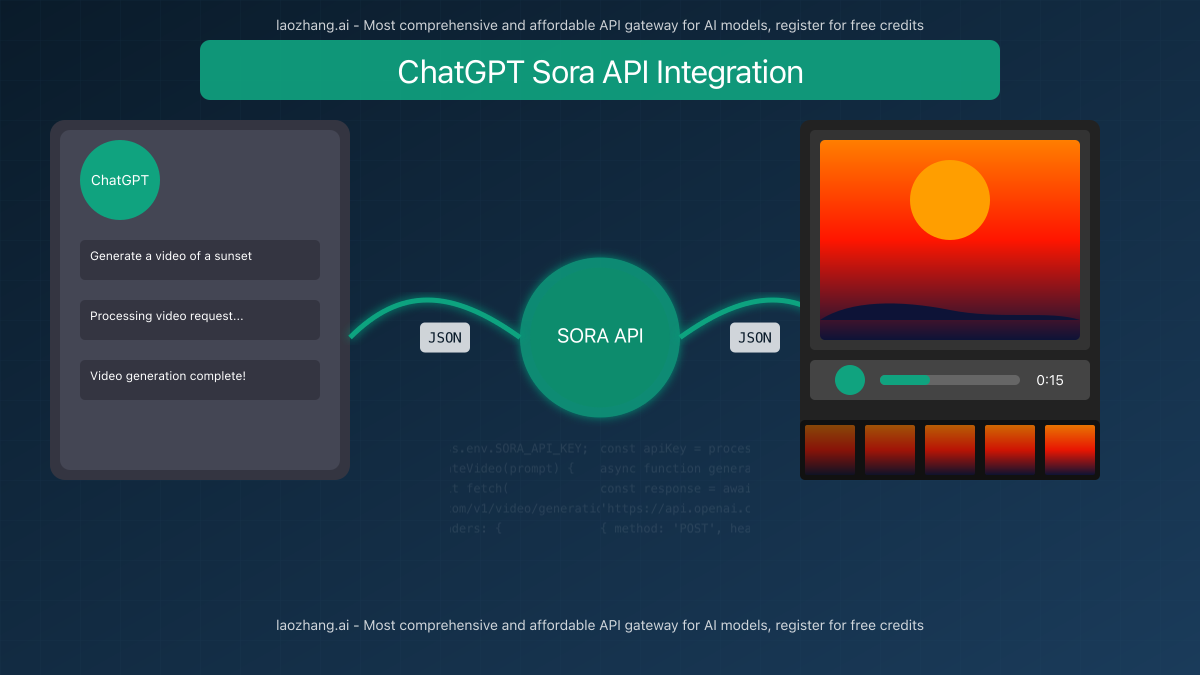
What is Sora and How Does it Integrate with ChatGPT?
Sora is OpenAI’s text-to-video generation model capable of creating videos up to 60 seconds long with remarkable visual quality and adherence to prompts. Announced in December 2024, Sora represents a significant advancement in AI video generation technology, producing content with consistent characters, accurate physics, and complex scene dynamics.
Key capabilities of Sora include:
- Generated videos up to 60 seconds at 1080p resolution (in full model)
- Support for text, image, and video inputs to generate new videos
- Realistic motion physics and temporal consistency
- Ability to understand and represent complex scenes
- Support for various camera movements (pan, zoom, tracking shots)
In March 2025, OpenAI announced plans to integrate Sora into ChatGPT, allowing users to create videos directly within the chat interface. This integration represents a strategic shift toward making video generation more accessible across OpenAI’s product ecosystem.
Current Status of ChatGPT Sora API Integration
Despite significant interest, as of April 2025, the Sora API is not yet publicly available. The current status of Sora’s availability can be summarized as:
- Sora is accessible to ChatGPT Pro subscribers ($200/month) with limited features
- ChatGPT Plus users ($20/month) receive 50 videos per month at 720p and 5 seconds duration
- OpenAI is gradually rolling out Sora to different regions, with the EU, UK, and Switzerland still awaiting access
- The standalone Sora web portal currently offers higher quality generation (up to 20 seconds at 1080p)
- A dedicated Sora API has been confirmed for future release but without a specific timeline
OpenAI is following a similar rollout strategy to other products like DALL-E and GPT-4, with a careful phased approach that prioritizes safety and scalability while gathering feedback from early users.
Expected ChatGPT Sora API Features and Specifications
While detailed specifications haven’t been officially released, we can make informed predictions about the upcoming Sora API based on OpenAI’s technical papers, developer discussions, and current ChatGPT integration:
| Feature | Expected Specification |
|---|---|
| Input Types | Text prompts, reference images, video clips |
| Output Resolution | Up to 1080p (likely tiered by subscription) |
| Video Duration | 5-60 seconds (tiered by subscription) |
| Format Support | MP4, WebM with various compression options |
| Content Controls | Content filtering, watermarking, metadata tagging |
| Rate Limits | Tiered by subscription level |
| Customization Options | Style presets, camera motion controls, editing capabilities |
The API is expected to support various authentication mechanisms, standard REST endpoints, and both synchronous and asynchronous processing models for different video generation workloads.
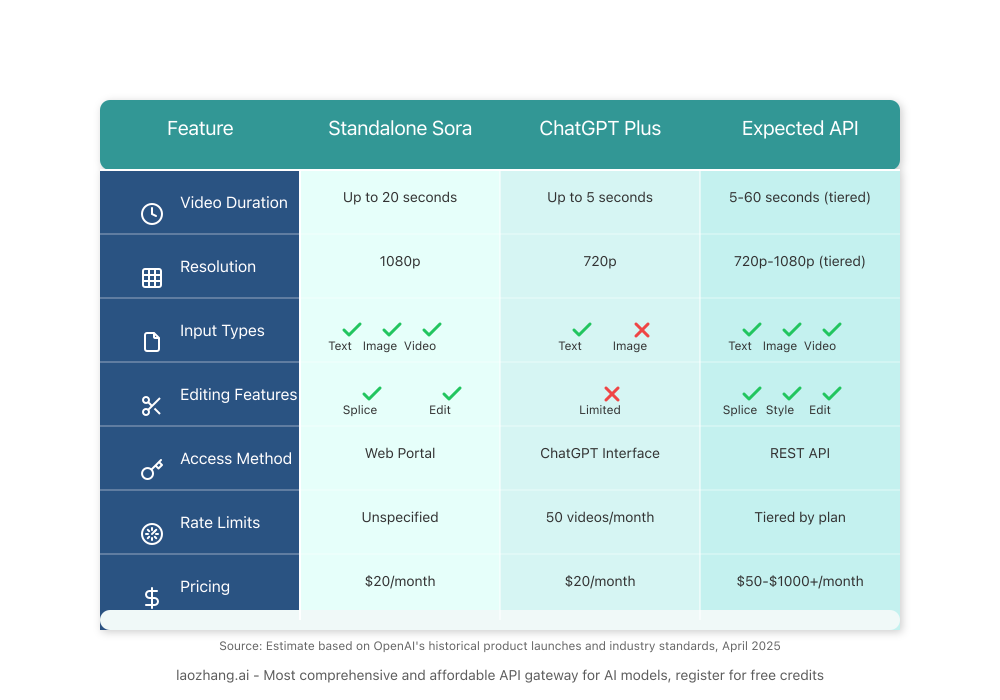
API Implementation Preview: Based on Current Documentation
While we don’t have official documentation for the Sora API yet, we can anticipate its structure based on OpenAI’s existing APIs. Here’s a potential implementation pattern:
curl -X POST "https://api.openai.com/v1/video/generations" \
-H "Content-Type: application/json" \
-H "Authorization: Bearer $API_KEY" \
-d '{
"model": "sora-1",
"prompt": "A cinematic shot of a person walking through a Tokyo street at night with neon signs and rain",
"duration": 10,
"resolution": "1080p",
"n": 1,
"response_format": "url"
}'
The expected response would include a URL to the generated video, metadata about the generation process, and potentially additional formats or thumbnails:
{
"id": "gen-video-2025-04-XcYbA",
"created": 1713801600,
"object": "video.generation",
"model": "sora-1",
"videos": [
{
"url": "https://openai-videos.com/generations/XcYbA",
"format": "mp4",
"width": 1920,
"height": 1080,
"duration": 10.0,
"frames": 240,
"thumbnail_url": "https://openai-videos.com/generations/XcYbA/thumbnail.jpg"
}
],
"usage": {
"prompt_tokens": 24,
"total_tokens": 24
}
}
This structure aligns with OpenAI’s current API design philosophy, focusing on simplicity while providing powerful functionality.
Potential Pricing Models Based on Industry Patterns
OpenAI hasn’t revealed official pricing for the Sora API, but based on their existing products and industry standards, we can anticipate several pricing tiers:
| Tier | Estimated Monthly Cost | Video Limits | Features |
|---|---|---|---|
| Developer | $50-100 | 100-200 videos/month | 720p, 5-10 second videos, basic features |
| Professional | $200-500 | 500-1000 videos/month | 1080p, up to 20-second videos, advanced features |
| Enterprise | $1000+ | Custom volume | Full resolution, duration, and feature access |
In line with OpenAI’s other products, the Sora API will likely use a credit-based system where different operations consume varying numbers of credits based on complexity, duration, and resolution.
Potential Use Cases for the ChatGPT Sora API
When the Sora API becomes available, it will enable numerous creative and commercial applications:
- Content Creation: Rapid prototyping of video concepts, generating B-roll footage, creating animated explainers
- Education: Visualizing complex concepts, creating historical reconstructions, producing instructional videos
- Marketing: Developing social media content, product demonstrations, and personalized marketing videos
- Entertainment: Creating short films, animating storyboards, generating game assets and cinematics
- E-commerce: Developing product showcases, virtual try-ons, and interactive shopping experiences
- UI/UX: Creating motion prototypes, interface animations, and interactive elements
- Real Estate: Generating virtual property tours and neighborhood visualizations
The API’s flexibility will likely support integration into existing creative workflows and enable entirely new applications that we haven’t yet imagined.
Safety Measures and Ethical Considerations
OpenAI has implemented several safeguards for responsible use of Sora:
- Visible watermarking and metadata tagging to identify AI-generated content
- Content filters to prevent generation of harmful or inappropriate material
- Usage restrictions on depicting real people or creating deceptive political content
- Rate limiting to prevent abuse or overuse of the system
- Human review of certain generation requests based on content flags
These measures reflect OpenAI’s commitment to preventing misuse while still enabling creative applications. Developers planning to use the Sora API should familiarize themselves with OpenAI’s usage policies to ensure compliance.
7 Best Alternatives to ChatGPT Sora API for Video Generation
While waiting for the Sora API to become publicly available, several powerful alternatives offer immediate access to high-quality AI video generation. Here are the top seven options you can implement today:
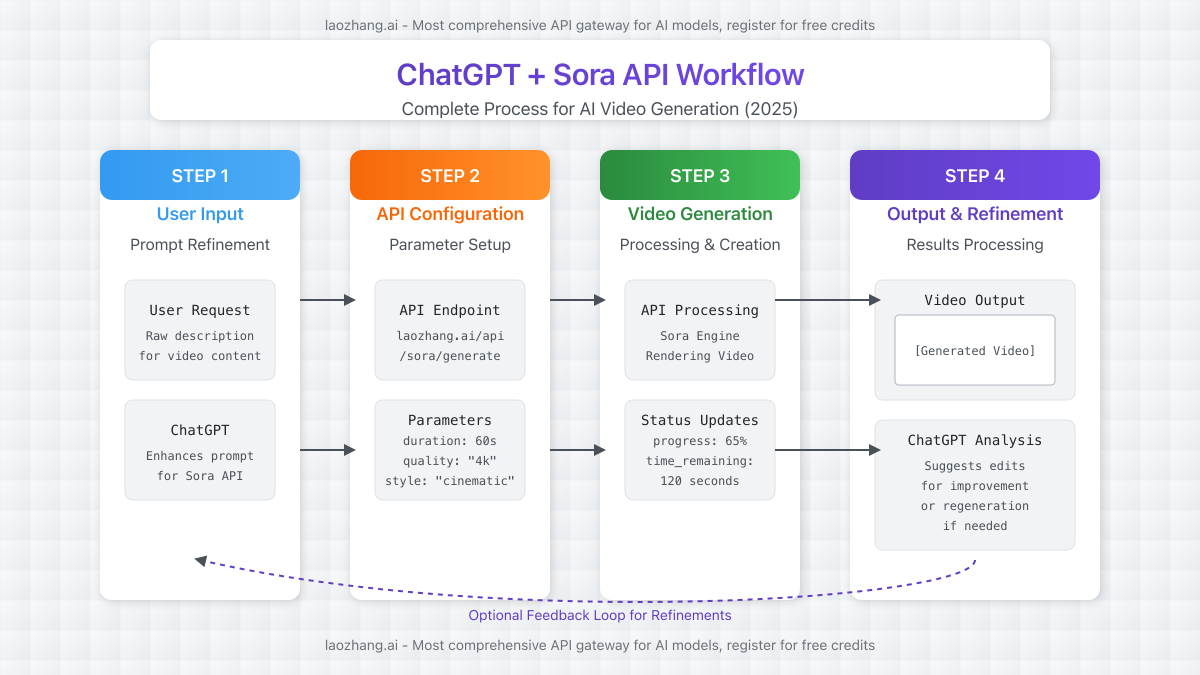
1. Runway Gen-3 API
Runway was one of the first companies to offer commercial AI video generation and has continued to innovate with their Gen-3 model.
- Key Features: Text-to-video, image-to-video, video-to-video, clip extensions, accurate lip-syncing
- Video Quality: High quality videos starting at 10 seconds long
- Pricing: Free plan with 125 credits; Standard plan at $15/month
- API Access: Well-documented REST API with SDKs for major programming languages
- Best For: Professional video production, collaborative workflows
Runway recently partnered with Lionsgate to integrate AI into studio production workflows, demonstrating its capability for professional-grade applications.
# Python example for Runway API
import requests
API_KEY = "your_runway_api_key"
headers = {"Authorization": f"Bearer {API_KEY}"}
response = requests.post(
"https://api.runwayml.com/v1/generation/text-to-video",
headers=headers,
json={
"prompt": "A drone shot of mountains with fog",
"length": 4.0
}
)
print(response.json())
2. Luma Labs Dream Machine API
Luma Labs offers impressive levels of realism and natural motion through their Dream Machine platform and Ray2 technology.
- Key Features: Chatbot-style interface, keyframes, clip extensions, character following
- Video Quality: High visual realism with natural physics and motion
- Pricing: Free plan with 30 generations/month; Lite plan at $9/month for 3,200 credits
- API Access: Developer-friendly API with webhook support
- Best For: High-quality visual storytelling with natural motion
Dream Machine excels at character consistency and extension capabilities, making it ideal for narrative-driven content.
3. Kling API
Kling, developed by Chinese video platform Kuaishou, offers exceptional motion quality and emotion portrayal.
- Key Features: Longer videos, multi-shot sequences, lip-syncing, improved movement
- Video Quality: Excellent at capturing human and animal motion with emotional depth
- Pricing: Free tier with 66 credits/day; Memberships starting at $10/month for 660 monthly credits
- API Access: REST API with comprehensive documentation
- Best For: Videos requiring realistic human movement and emotional expression
Version 1.6 released in January 2025 significantly improved character consistency and camera movements, bringing cinematic quality to generated videos.
4. Hailuo MiniMax
Hailuo MiniMax has quickly become one of the most realistic text-to-video models available, particularly for human emotional expressions.
- Key Features: Text-to-video, image-to-video, specialized image-to-video live for animations
- Video Quality: Excellent at depicting human emotion with realistic details
- Pricing: Base plan at $9/month for 1,000 credits, no watermarks
- API Access: REST API with comprehensive documentation and code examples
- Best For: Human-focused videos with emotional storytelling
Their latest release includes the open-sourced MiniMax-01 series with impressive multimodal capabilities.
5. Haiper API
Haiper focuses on accurate prompt following rather than precise motion control, with a strong emphasis on artistic expression.
- Key Features: Text-to-video, text-to-image, image-to-video, template-based generation
- Video Quality: Strong prompt adherence with artistic styles
- Pricing: 100 free credits; $10/month for 1,500 credits on latest model
- API Access: REST API with straightforward implementation
- Best For: Creative and artistic video content with specific visual styles
Their iOS app facilitates mobile video creation, bringing AI video generation capabilities to a broader audience.
6. Pika Labs API
Pika offers a well-rounded video generation platform with particularly strong camera controls.
- Key Features: Text/image-to-video generation, cinematic camera controls, “Pikadditions” for adding elements
- Video Quality: Smooth motion and professional camera movements
- Pricing: Free plan with 150 credits; $8/month (yearly billing) for 700 monthly credits
- API Access: REST API with comprehensive documentation
- Best For: Content requiring professional camera movements and cinematic quality
Pika’s strength lies in its camera control capabilities, making it ideal for filmmakers and content creators.
7. Open-Sora (Open Source)
For developers seeking an open-source solution, Open-Sora provides a fully transparent implementation that can be customized and extended.
- Key Features: Text-to-video, image-to-video, video extension, multi-resolution support
- Video Quality: Competitive quality that continues to improve with community contributions
- Pricing: Free and open-source
- API Access: Direct code implementation with full transparency
- Best For: Developers needing customizable solutions and full control
Open-Sora 2.0, released in March 2025, significantly narrows the quality gap with commercial solutions and can be trained with a reasonable budget of approximately $200K.
Technical Comparison: Open-Sora vs. Commercial APIs
Open-Sora offers unique insights into video generation architecture that can inform your API selection:
| Component | Open-Sora Implementation | Commercial API Approach |
|---|---|---|
| Video Compression | Stacked VAE (2D spatial + 3D temporal) | Proprietary compression, typically with higher ratios |
| Training Method | Rectified flow with logit-norm sampling | Various diffusion approaches, often proprietary |
| Architecture | Transformer-based diffusion with temporal attention | Similar base architecture with proprietary enhancements |
| Model Size | 1B-11B parameters depending on version | Typically 10B+ parameters for top commercial models |
| Deployment | Self-hosted or cloud with sequence parallelism | Managed cloud services with optimization |
Understanding these technical differences can help you choose the right solution based on your requirements for quality, control, and cost.
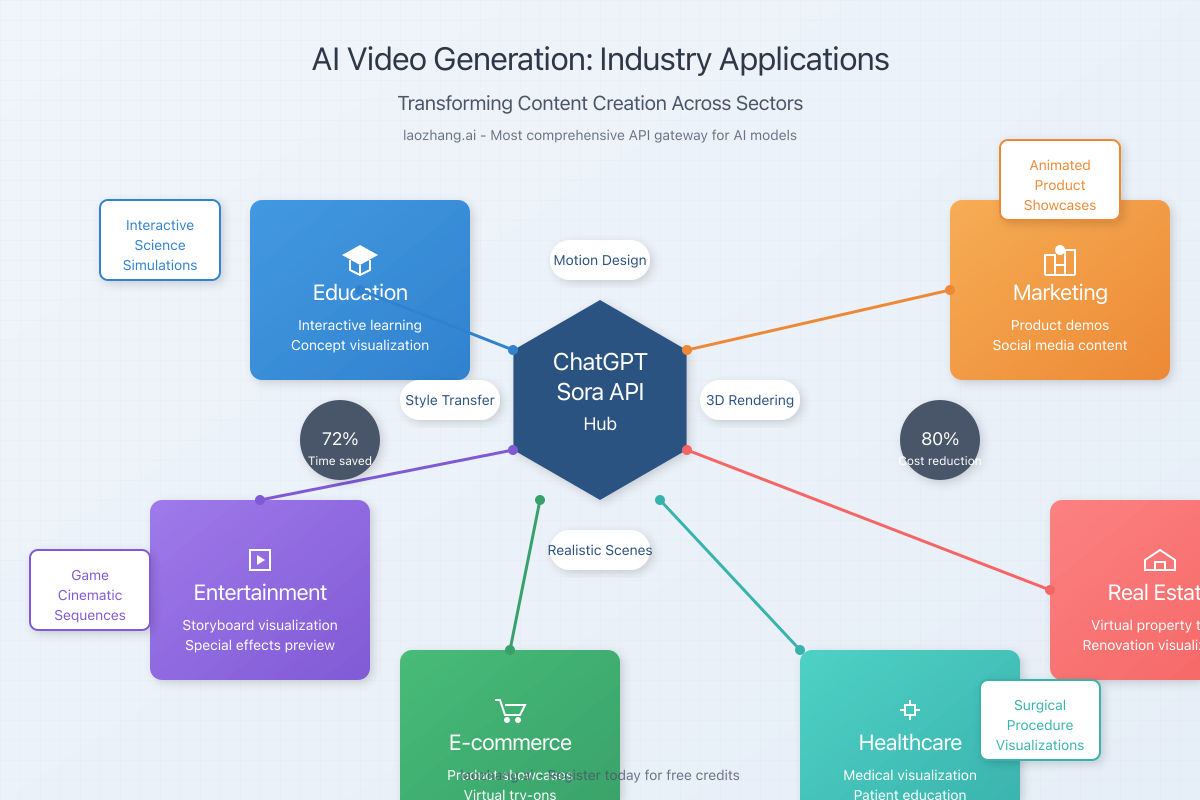
Integration Guide: Incorporating Video Generation APIs into Your Applications
Successfully integrating AI video generation into your applications requires careful planning:
Implementation Best Practices
- Asynchronous Processing: Video generation is computationally intensive. Design your application to handle asynchronous processing using webhooks or polling.
- Prompt Engineering: Create a library of effective prompts and templates that reliably produce desired results.
- Progressive Enhancement: Start with basic functionality and add advanced features as you understand the API’s capabilities.
- Caching and CDN: Implement caching for generated videos to reduce API calls and improve performance.
- Error Handling: Develop robust error handling for generation failures, timeout scenarios, and content policy rejections.
Sample Application Architecture
Frontend → API Gateway → Video Generation Service → Storage → CDN
↓ ↓ ↑
Auth Service Queue System Database
This architecture separates concerns and provides scalability for handling multiple video generation requests efficiently.
The Future of ChatGPT Sora API and AI Video Generation
As we look ahead to the full release of the ChatGPT Sora API, several trends are likely to shape the landscape of AI video generation:
- Increased Resolution and Duration: Expect support for 4K resolution and videos exceeding one minute as models and computational efficiency improve.
- Enhanced Control: More granular control over scenes, characters, and camera movements will become standard features.
- Multi-modal Input: The ability to combine text, images, audio, and existing video for more precise results will continue to evolve.
- Industry-specific Solutions: APIs tailored to specific sectors like education, marketing, and entertainment will emerge with specialized features.
- Regulatory Response: Expect evolving regulations around AI-generated video content, potentially requiring standardized watermarking and disclosure.
Staying informed about these developments will help you prepare for the evolution of this technology and position your applications to leverage new capabilities as they emerge.
laozhang.ai: Cost-Effective API Solution for AI Integration
For developers looking to experiment with multiple AI video generation models without committing to individual subscriptions, laozhang.ai offers a comprehensive API middleware solution that provides access to various AI services including video generation capabilities.
Key Benefits of laozhang.ai:
- Single API access point for multiple AI models including GPT-4o, Claude, and video generation services
- Cost-effective pricing with pay-as-you-go options
- Free credits upon registration for testing
- Simplified authentication and standardized request format
- Reliable performance with high uptime guarantees
Integration Example:
curl -X POST "https://api.laozhang.ai/v1/chat/completions" \
-H "Content-Type: application/json" \
-H "Authorization: Bearer $API_KEY" \
-d '{
"model": "gpt-4o-image-vip",
"stream": false,
"messages": [
{
"role": "user",
"content": [
{
"type": "text",
"text": "Generate a video of cats playing"
}
]
}
]
}'
Register at https://api.laozhang.ai/register/?aff_code=JnIT to receive free credits and explore the capabilities of this integrated solution.
Conclusion
While the ChatGPT Sora API isn’t yet publicly available, the current landscape offers compelling alternatives that can meet immediate video generation needs. From commercial solutions like Runway and Dream Machine to open-source options like Open-Sora, developers have multiple pathways to implement AI video generation today.
As you evaluate these options, consider your specific requirements for quality, control, cost, and integration complexity. For many applications, the existing alternatives may already exceed your needs, while others may benefit from waiting for Sora’s official API release.
The future of AI video generation is rapidly evolving, with new capabilities emerging regularly. By understanding the current state of the technology and preparing your applications for integration, you’ll be well-positioned to leverage these powerful tools as they continue to advance.
Whether you choose to implement one of the available alternatives or wait for the official ChatGPT Sora API, the transformative potential of AI video generation is clear – opening new creative possibilities and streamlining video production workflows across industries.
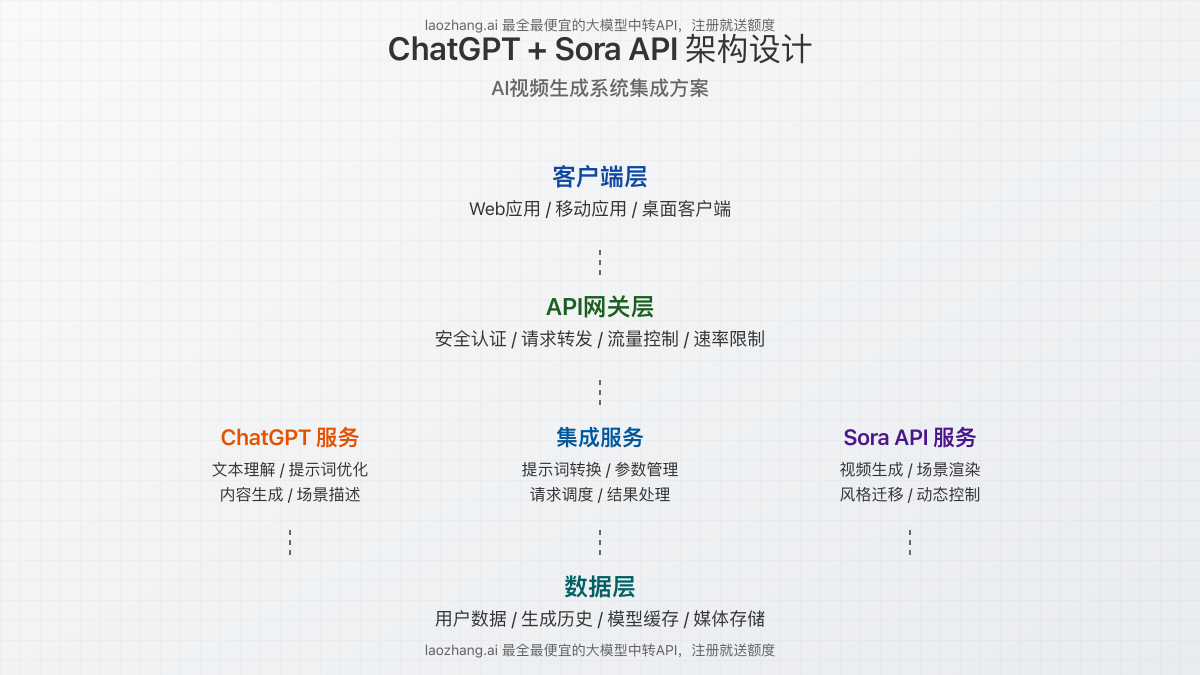
Important Note: AI video generation technologies are evolving rapidly. Always check the latest documentation from API providers for the most current information on capabilities, pricing, and usage policies.